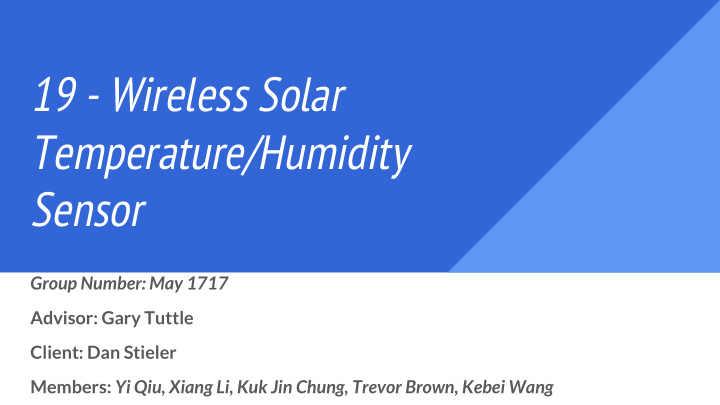



19 - Wireless Solar Temperature/Humidity Sensor Group Number: May 1717 Advisor: Gary Tuttle Client: Dan Stieler Members: Yi Qiu, Xiang Li, Kuk Jin Chung, Trevor Brown, Kebei Wang
Our Advisor & Client Advisor: Gary Tuttle Client: Dan Stieler ( Powerfilm Company)
Problem Design a low power consumption circuit system that measure temperature and ● humidity Data has to be wirelessly transmitted to mobile devices ● The system should be solar powered and physically small ●
Problem Statement This solar powered system needs to measure the temperature and humidity as ● well as translate the data through wireless transmission to mobile devices The view of design and analysis is on how much low power that the system can ● consume and be useable
Solution Consider different ways of data transmission and test different sensor ● technologies for lowest power consumption We also need to choose the solar panel and battery to work continuously in low ● light conditions
Purpose of Project Provide wireless temperature and humidity data on a mobile device ● Reduce power consumption ● Extend the operating time for the battery ○ System last longer without recharging at night ○ Makes the system physically smaller ○
Requirements Functional Requirements ● Keep the system operable under 400 lux light level ○ Keep power consumption low ○ Precisely measure and record the temperature and humidity changes from ○ the sensor Non-Functional Requirements ● ○ The scale of the system should be small Operating Environments ● ○ The system should work effectively within 10 meters indoors and outdoors
Functional Decomposition
Design Detail Temperature/Humidity Sensors: LM35 HDC1080 DHT22 DHT11
Sensor Details
Wireless Communication We want to use Bluetooth for lower cost and decide to use Bluetooth low ● energy as it consume less power than traditional Bluetooth and WiFi
Design Detail BLE Module: Nordic NRF8001 IC on Adafruit module board
Design Detail nRF52 DK
Design Detail Sparkfun NRF52832 Breakout ● Uses reference design for NRF52832 ○ Small usable package that is easy to program ○ Lower power consumption than the NRF52 DK ○
Design Detail LG 18650 Rechargeable Lithium polymer battery 401525 Lithium Ion with Protection Device 110mAh 3.7V 3200mAh 3.7V
Design Detail Solar panel: 2 Volt open circuit output, 35uA short circuit current at 400 lux test level
Design Detail Power Management: TI BQ25570 Energy Harvester Development Board ● Takes the power from the solar panel and charges the battery using switching mode power ○ supply
First Design Test Circuit Components Used Arduino Uno ● NRF 8001 ● Temperature sensors ● LM35 ○ DHT11 ○ DHT22 ○
First Design Test Circuit Communication Protocol Sensors LM35 - Analog signal ● DHT11 and DHT22 - Digital signal 1-wire ● Micro BLE Module Controller (NRF8001) (Arduino Uno) Mobile devices
First Design Circuit Revised Components Used Arduino nano ● NRF 8001 ● Temperature sensors ● HDC1080 ○
First Design Circuit Revised Communication Protocol Sensors HDC1080 - I2C ● Micro BLE Module Controller (NRF8001) (Arduino Nano) Mobile devices
First Circuit Testing Current is measured using Signal ● Express and a multimeter 500uA average current during ● transmission
First Circuit Revised Bill of Materials
First Design Circuit Results 1. We found out which components consumed the most power 2. Chose the best sensor based on power consumption and accuracy
Programming Libraries SPI.h - Serial Monitoring ● Wire.h - I2C communication ● Adafruit_BLE_UART.h - BLE UART communication ● ClosedCube_HDC1080.h - HDC1080 Arduino functions ● DHT.h - DHT sensor functions ● BLE Peripheral - Final BLE functions ●
Second Design Circuit Sensors Micro BLE Module Controller (NRF8001) NRF 52 (Arduino Nano) Mobile devices
Second Design Circuit Lower power consumption ● Lower voltage supply(1.7 V - ● 3.7V) Include BLE module with ● microcontroller inside NRF 52
Software Challenge Nordic programing ● software uVision5 to test the NRF52 BLE function inside the microcontroller
Second Design Circuit NRF52 Development kit design was abandoned due to programming ● difficulties uVision 5 was very hard to use and implement the library for our temperature ● sensor
Final Design Circuit The final version circuit uses the Sparkfun NRF52382 along with the ● temperature sensor This was easier to program than the NRF52 development kit ● Smaller and less board area than the development kit ●
Final Design Circuit HDC1080 BLE Module (NRF52 NRF52 Breakout) Mobile devices
Final Design Circuit Eliminates the NRF52 ● development kit extras to lower power consumption Easier to program ●
Final Design Circuit The final design circuit was easier to program via Arduino IDE ● The library for the HDC1080 was hard coded into the BLE serial program ● HDC1080 library did not work as wire.h library is implemented differently on ● the NRF52382 BLE serial program from the BLE Peripheral library is the only way to get the ● same mobile functionality as the first circuit
Final Circuit Testing Consumed more current than the 2nd ● circuit Serial function is coded in a way that ● consumes more power than the 2nd circuit 6.5mA average current ● Battery lasted over 16 hours ● transmitting at 1Hz without the solar panel
Final Design Bill of Materials
Conclusion: We figured out which part in the system consumes the most ● power We chose the lowest power consuming components to ● reconstruct the circuit. Different current consumption occurred based on the ● programing and different BLE modes.
Bill of Components
Market Research Name of product LACrosse Technology Solar Oregon scientific BAR206 Weather Our Design Powered Wireless Temperature Forecast Temperature Station Station and Sensor -WS-8120U-IT-BR-T Price $42 $44.99 $32.40 Transmission Distance 200 ft. 98 ft. 33 ft. Maximum Humidity Range 20%-95% 25%-95% 0%-100% Maximum Temperature -39.6°C-59.9°C -5°C - 60°C -40°C-125°C Range Operating time without solar 12 h 12h-24h 16h panel
Questions ?
Recommend
More recommend